You’ve seen countless examples of shipping container homes and projects throughout our website. And even within the category of homes, there are quite a few different possibilities.
With the base unit of a shipping container, you can go in many different directions with regards to size, shape, and architectural design. The creativity afforded by steel containers allows for almost endless ideas.
More and more people are moving beyond logs and lumber toward a sturdy cabin solution based on containers. We love the idea of shipping container living in general as well as container home cabins specifically. Read on to find out why!
What is a Cabin Anyway?
While the word ‘cabin’ is often visualized as a log cabin, the term is actually much more generic. To make matters more confusing, there are quite a few building types that are very similar to cabins. Let’s start with a definition.
Depending on your dictionary of choice, the definition of a cabin is usually a small dwelling, house, or shelter that is made with simple construction and often situated in a wild or remote area. Some definitions further elaborate by saying that a cabin is usually made of wood. However, languages evolve over time and the term has become more inclusive.
While there are regional and cultural differences, we can generally say that a modern cabin meets most but not necessarily all of the following criteria:
- It’s smaller than an average or ‘normal’ house in the same area
- It’s intended for only one person or a small group or family
- It’s not intended as a primary residence but as a seasonal or second home
- It’s located in a somewhat rural area
- It’s built relatively simply with common materials and tools and without complex designs
- It’s built, at least in part, by the person(s) who will live there
As you can see, the criteria is less about specific construction materials or style and more about the size and planned usage. Hence, why building a cabin out of shipping containers is perfectly acceptable.
It’s important not to get too wrapped up in what qualifies as a cabin. For instance, while all cabins are houses, not all houses are cabins. The lines between categories can be gray and there is a lot of overlap. When in doubt, refer back to the bulleted list above.
Let’s talk about a few buildings that similar to cabins to make sure we’re not leaving anything out. While there are even more subtle cabin varieties that are specific to certain countries, like the Canadian Bunkie, the New Zealand Bach, the Russian Dacha, and the Swedish Stuga, we’re focusing on options that are most common in the US.
- Chalet: With origins in Switzerland, chalets typically have a distinct architectural style (more info). Increasingly, the term is used more generically for a house used during a ski vacation. We’ve seen containers used at ski resorts before, so a shipping container chalet is certainly viable.
- Mountain Hut: These high-altitude shelters are relatively spartan and are intended for use by hikers, climbers, and even skiers (more info). As long as it is well-insulated to keep condensation from occurring, a shipping container hut can make sense. However, many huts are located in areas that would be inaccessible to a large truck or crane, in which case another type of construction would probably be more suitable.
- Lodge: In many cases, a lodge is just a larger, nicer cabin that’s often used by multiple families at once (and is sometimes surrounded by several smaller, traditional cabins). While losing some of the cabin attributes from above, it’s still generally not used as a primary home and is located in a rural area. By utilizing more than one box, you could easily build a shipping container lodge that holds all your family and friends.
- Cottage: Synonymous with a smaller house, though the location is more accurately described as semi-rural. You might find a cottage beside a lake or in the countryside near a small town, but not necessarily in the woods. Cottage can also denote a certain type of architectural style. If you want to make a shipping container cottage, external cladding is a great way to replicate the architecture style while still having a durable container as a base structure.
- Summer or Holiday House: Summer houses capture some of the essences of a cabin (like being a distinctly seasonal or holiday home) while shedding descriptors around size and location. There’s no reason you couldn’t use a shipping container as the basis for a summer house, and the great security of containers actually makes it an ideal choice.
- Bungalow: Somewhat cabin-like while not exclusively rural, a bungalow is usually more of a smaller house in a city that has a sloped roof with large verandas or porches. Shipping container bungalows are an obvious idea, given that much of container architecture is also centered on smaller floor plans.
Regardless of what you specifically call it, where it is, or what exactly it looks like, a cabin is designed to solve a problem. The issue is this: How to come up with a structure that is secure and durable, efficiently uses a small amount of space while being cozy and livable, and is fairly straightforward for the average person to build themselves.
If you’ve read through our Fundamentals section, you’re probably now saying to yourself, “Hey, that sounds a lot like a container house!” And of course, you’d be right, which is why a container cabin makes so much sense!
Pros and Cons of Shipping Container Cabins
While there are many great reasons why a container works well as a cabin, it wouldn’t be fair to just share the beneficial attributes. So below we’ll do our best to describe both the good and bad aspects of containers as they pertain to cabin homes.
Positives
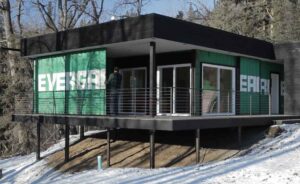
- Environmentally Friendly: If you’re interested in cabin, you’re probably also interested in nature. Traditional cabins are often made of logs or lumber. The fewer logs you purchase or trees you cut, logs, the more trees stay rooted in nature. A container can definitely reduce your environmental impact by requiring less wood. There is also the aspect that by building a cabin from a used container, you’re repurposing something instead of building something brand new. If this is all new information, we’d recommend reading our articles about the history of container building and how container building can increase your sustainability.
- Low Cost: Shipping container homes are often cheaper or at least comparable to the cost of similarly equipped and sized traditional homes. When you think about most cabins being DIY projects, shipping containers start to make even more sense. The most difficult and expensive parts of homebuilding are already covered by the container’s weatherproof and structurally sound envelope.
- Safe: In a shipping container cabin or home, you’ll feel safer than you’ve ever felt. If you’ve ever been robbed or vandalized, you know the feeling of paranoia. Shipping container homes and cabins are much harder to break into than a traditional house or cabin. And the metal walls of the container keep out animals and inclement weather just as well as thieves. After all, it’s unlikely that anyone is going to break through solid steel in the middle of the night.
- Tightly Sealed: Containers are built incredibly well so that the contents don’t get spoiled on the journey over the open ocean. That same quality helps keep out drafts, bugs, mice, etc. just as well. You won’t have to worry about arriving at your cabin for summer vacation to find mice have chewed through your floorboards or termites have devoured your porch. And while you’re inside, a cold breeze will never find it’s way through the steel walls.
- Adaptable: Shipping container cabins are adaptable in almost every sense of the word. First, you can create any design or style of home you wish using shipping container construction. Go wild with your designs. If you choose to, you can add on more shipping containers or stack them on top of each other to create more room. It doesn’t matter if it’s a few months or years later. You can also move your shipping container anywhere with the help of a crane or heavy-duty truck. Plus, if you want to switch up where your get-away shipping container cabin is located, you can do so. You can’t do that with a lot of traditional cabins without destroying their structural integrity.
- Fast Construction: Shipping container cabins can be much faster to build than a traditional home. With a traditional home, you’re starting from the bottom up. With a shipping container, the basics like a roof, walls, and floor are already done. Yes, you’ll probably need insulation and details like windows and doors, but those are much simpler and faster to build than entire buildings. You’ll end up spending less time overall on your cabin build if you start with a shipping container. And if you get sidetracked by weather, other projects, or budget, you can rest easy knowing that your container will be secure until you’re ready to finish it.
- Sturdy: It’s no secret that shipping containers are tough and that directly applies to using them as building blocks as well. Yes, this makes them secure and safe as we discussed above. But it also makes them resilient. A cabin made from a container should last for decades with very few improvements that you’ll have to worry about in your lifetime. Consider it an heirloom and pass it down to your children if you want.
Negatives

- Heavy: There’s no way to get around it. The same thing that makes shipping containers so sturdy also makes them very heavy. For instance, a standard 20 ft container like the one in the picture above weighs about 5,000 pounds empty. Depending on your building site, that’s weight that will have to be carried up-hill, dragged through marshland, and hoisted over trees. However, if you don’t have an especially challenging building site this may not matter to you.
- Dependent on Power Tools: Many of the modifications required to convert a shipping container to a cabin require power tools. Grinders, drills, and welders are usually needed to cut and attach metal as you form windows and doors. Doing this work on-site would require a source of power, either a generator or electrical service. The way around this would be to perform all the large modifications in town before moving the modified container to the building. This way, all on-site modifications could be accomplished with only hand tools.
- Height: A lot of traditional cabin designs utilize lofts as sleeping areas. Lower ceiling heights obviously aren’t a concern when you’re laying down. It enables you to have a much larger space with only a small increase in house size. However, even a high-cube container only has an internal ceiling height of 8 ft 10 in, and that’s before insulation is added. Now, you can cut the top off of containers in places to add raised sections for lofts, or you can stack multiple containers on top of each other. In some ways, this achieves the same effect, but it isn’t as straight forward.
Shipping Container Cabin Examples
Clearly, the positives outweigh the negatives, which is why so many people have decided to build shipping container cabins over the years. Below, we’ll share a few great examples.
Remote California Container Cabin
This two-container cabin was built with security in mind. Designed by Yamamar Design, it incorporates sliding door panels made from the container wall cutouts. In addition, the existing container end-doors can be opened to reveal a huge window.
This off-grid container cabin excels at letting light and nature in while it is being used, but can also be completely locked down and secured when it’s time to head back to life in the big city.
A simple bed of gravel serves as the foundation, making this a quick, cheap, and low impact build for those wanting to get away to a beautiful property like this.
Red River Gorge Container Cabins
Kentucky’s Red River Gorge is a scenic area of canyons, forests, and waterfalls. A fitting location for two similar container cabins available for rent.
Both of the cabins are built from two 40 ft shipping containers, although the larger cabin (shown above) has the two containers separated to give more room in between.
The design seamlessly blends modern and rustic with features like wood-paneled walls, concrete countertops, and corrugated sheet metal ceilings. While both cabins have two bedrooms and one bathroom, the smaller cabin sacrifices some indoor space for a sprawling covered porch.
Catskills Container Cabin
This charming cabin is built from a single 20 ft container. Set in Catskill Mountains of New York just a couple of hours north of the city that never sleeps, this cabin embodies relaxation.
Surrounded by forest and near to a waterfall, this cabin encourages you to really enjoy the outdoors. And with two huge sliding doors in addition to a large window, you feel like you’re outside even when you’re snuggled up on the couch.
Barnwood Builders Container Cabin
This rustic looking cabin gives no visual indication that it’s built with a shipping container, and that’s the point. The team at Barnwood Living build this cabin as part of their TV show about salvaging wood from old barns.
Using a standard 20 ft container as the base, the team cut out two windows and a door, then got to work cladding the exterior with salvaged wood from a nearby barn. They also built a separate front porch to match the container’s design.
One unique feature is the ceiling. They cut out the entire roof of the container then used hand-hewn wooden beams to form a gable roof covered in sheet metal. When you look up inside, you see the exposed beams and lumber sheathing.
This container cabin is a great example to showcase that a container cabin doesn’t actually have to look like a container. If you want the advantages of a container like strength and portability, but desire a more rustic appearance, that is definitely possible.
Hideaway Litchfield Luxury Container Cabins
While this cabin is out in nature, you definitely don’t have to rough it. Hideaway Litchfield consists of two luxury container cabins in Australia’s Litchfield National Park.
Each of the cabins are made with two containers that are cut at angles. In addition, the containers have corrugated metal as an exterior cladding. It is very difficult to tell these are container cabins…you almost have to see the under-construction photos to believe it!
With an incredible national park right outside, the location couldn’t be better. And the quality of the build means you’ll suffer for nothing when you come inside after a long day of exploring.
Modern Beach Container Cabins
These modern container cabins aren’t nearly as rural as some of the others we’ve featured, but given their proximity to the beach, we’re making an exception! Each of the two cabins is made with a single 40 ft shipping container elevated above the ground on piers.
The design of these container cabins is accurately described as simple yet elegant. White walls and tiles mesh wonderfully with the rich brown of the coated container floor. And the bold, blue exteriors look right at home with the wooden decks and native landscaping. One of our favorite features of these cabins is the huge outdoor showers, perfect for washing off beach sand or sweat from a run.
Despite how great these cabins look, a DIYer could replicate them fairly inexpensively. There are no fancy materials or ornate designs, just a well thought out use of space and color.
Hideout Off The Grid Container Cabin
The Hideout OTG Cabin was a concept created by architect Richard Springwater several years ago. It has some very interesting features for container cabin fans and borrows the idea of slideouts from the RV industry.
As you can see from the picture, this cabin is based on a 20 ft container that has a fold-down wall. When the wall is down, a lightweight extension full of windows moves out sideways. This effectively doubles the interior volume of the cabin.
If you need to move the cabin or just want to secure it when you are gone, you can retract the windowed extension and fold the steel wall back up. Packed up like this, the cabin looks just like a regular container with no window or door penetrations.
Many of you will rightly point out that all the windows will be horrible for privacy, insulation, and potential condensation. We prefer to think of this cabin as the start of an idea rather than a finished design.
For instance, in many geographic areas, you’d want to replace some of the windows with insulated panels. And it might be easier to use a open-sided container instead of fabricating a fold-down wall.
Canadian DIY Container Cabin
This cabin is a great example of what a DIYer can build with a little bit of work. Built with three 20 ft containers, this cabin reportedly only cost $20,000.
By placing all windows and doors in the open ends of the three containers, the cabin is very secure. When not in use, the three sets of steel container doors can be shut and the cabin has almost no external holes.
Even though the windows are all on one wall, using 20 ft containers means the home is fairly shallow and light fills the space without issue. External insulation on the roof and internal insulation in the walls helps keep the space at a comfortable temperature.
We’d prefer to see some siding placed on top of the OSB for aesthetic purposes, but otherwise, this container cabin is just about perfect for a budget build.
Shipping Container Log Cabin
This container cabin takes the idea of log cabins and marries it with the strength of shipping containers. The picture above is while it was under construction just so we can prove there is a container underneath!
Made with only a single 20 ft container, this cabin isn’t especially spacious but it gets the job done. The fully laced log stack cladding helps keep the sun off of the container walls while also giving it that classic rustic appearance.
To get more information about this particular cabin, check out our interview with the owner.
Riverside Hideout Container Cabin
This great shipping container cabin rental in Ohio was a family’s DIY project. Based on a single 40 ft container, it is placed on a scenic piece of property near a river that is full of color as you can see from the picture.
A four-season cabin like this is surprisingly easy to build, and thanks to its cozy size, easy to keep warm in the winter. We especially like the clear-coated plywood flooring which looks great while being quite economical.
For more information on this cabin build, read our interview with the owner.
Conclusion
We’ve really just scratched the surface of the multitude of possibilities that shipping containers can bring to cabins. Hopefully, some of the examples have sparked some ideas in your head to prove that almost anything is possible.
While shipping containers aren’t perfect for every situation, we think you’ll agree that we’ve made a great case for using them for a cabin project.
As you can probably imagine, many container cabins are created to use as short term rentals (either exclusively or when the owner isn’t using it). If you’re interested in seeing some container cabins and other types of container homes available for short rental stays, definitely check out our Visit tool. It’s a fun way to spend a weekend and find out if staying in a container is right for you and your family.
Let us know what you think about container cabins in the comments below.

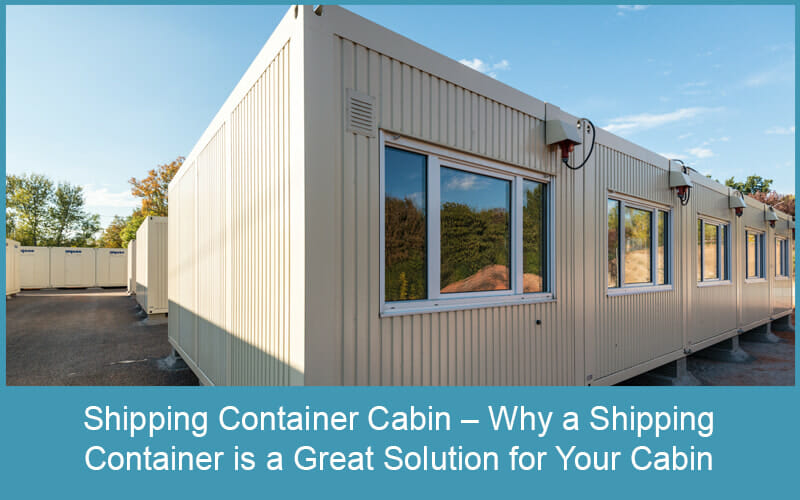

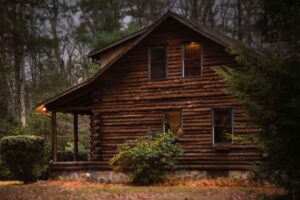
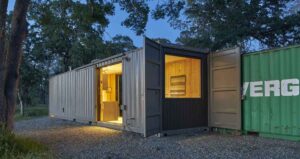
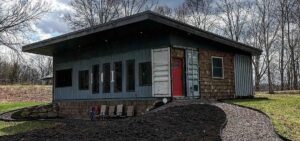
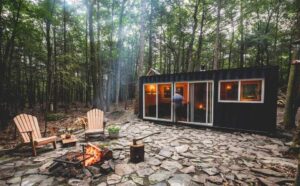
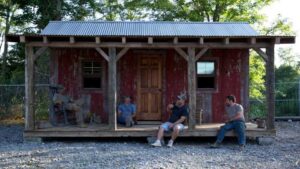
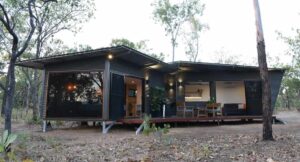
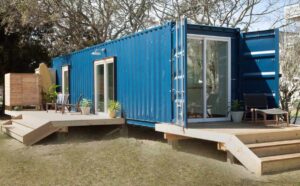
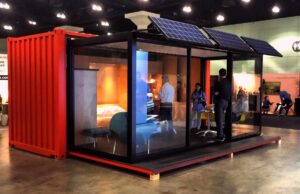
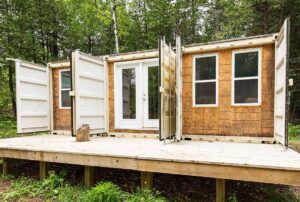
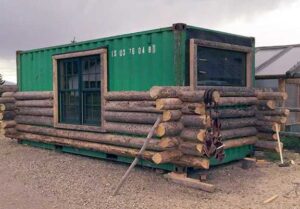
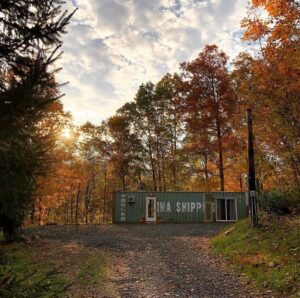

2 Responses
dp you sell plans for container cabins?
We sell plans for container homes of a variety of sizes, including some that could be considered ‘cabins’. You can take a look at our Store for more info: http://www.discovercontainers.com/store/